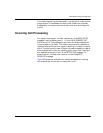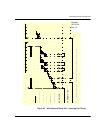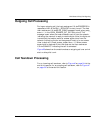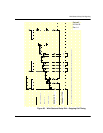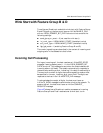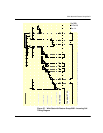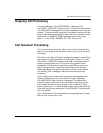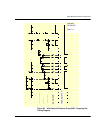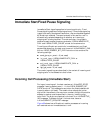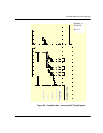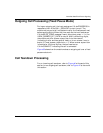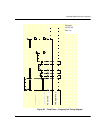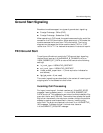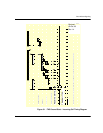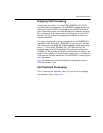
Immediate Start/Fixed Pause Signaling
November 2009 285
Immediate Start/Fixed Pause Signaling
Immediate Start signaling applies to incoming calls only; Fixed
Pause signaling applies to outgoing calls only. Since these signaling
types functionally complement each other, they are handled together
by Brooktrout modules. The exact protocol to be used for a call is
automatically selected depending on whether an incoming or
outgoing call is being handled. To avoid confusion, the symbolic
constants used to select these two protocols, IISDNttIMMEDIATE_
DIAL and IISDNttFIXED_PAUSE, are set to the same value.
To configure a Brooktrout module for immediate start and fixed
pause mode signaling, the host must issue an L4L3mENABLE_CAS
with an IISDN_ROBBED_BIT_DATA structure that contains the
following settings:
send_glare_err_event = 0 (not used)
in_trunk_type = IISDNttIMMEDIATE_DIAL or
IISDNttFIXED_PAUSE
out_trunk_type = IISDNttIMMEDIATE_DIAL or
IISDNttFIXED_PAUSE
fgb_fgd_mode = 0 (not used)
The remaining settings are described in the context of incoming and
outgoing calls in the subsections that follow.
Incoming Call Processing (Immediate Start)
During an incoming call, the host receives an L3L4mPRE_SEIZE
message if send_preseize_event = 1 in the IISDN_ROBBED_BIT_
DATA structure. This message is sent when the module detects an
incoming seizure (off hook). The module then collects dial pulse
digits from the network; the maximum number of digits the module
expects to receive must be specified in the max_incoming_digit_
count field. The digits are reported to the host in an L3L4mSETUP_
IND message. To answer the call, the host must issue an
L4L3mCONNECT_REQUEST message.
Figure 29 shows how a Brooktrout module processes an incoming
call received over an immediate start trunk.



